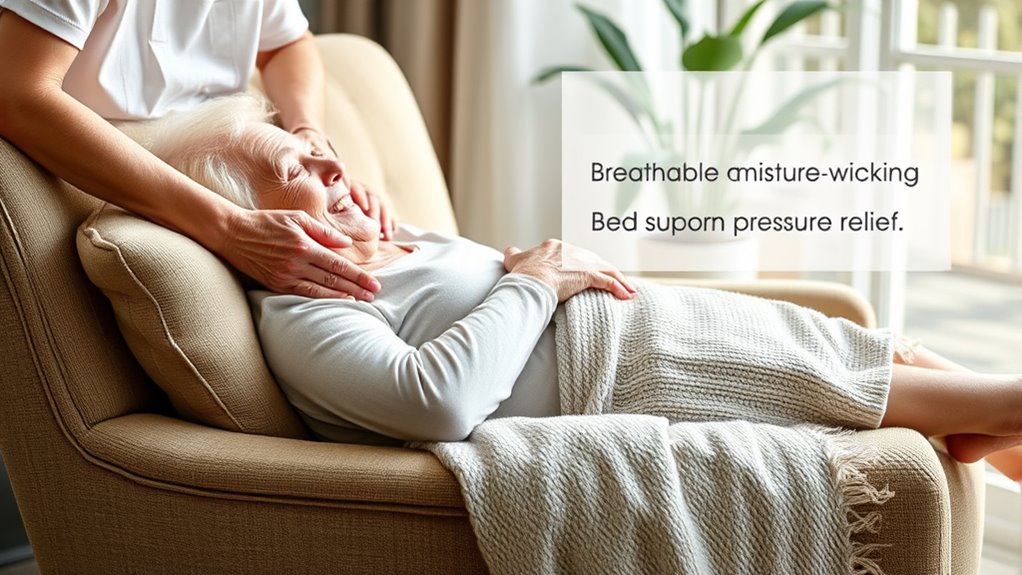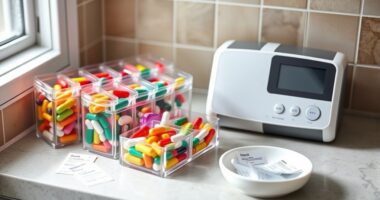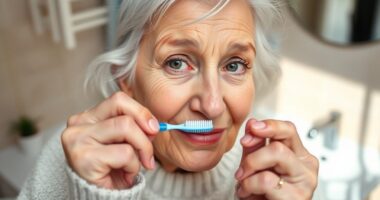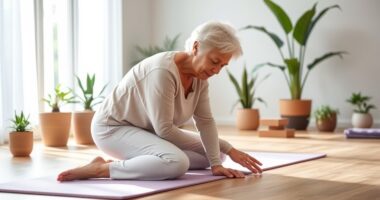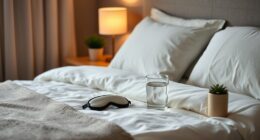To prevent bedsores in seniors, you should regularly change their position every two hours and use supportive devices like cushions or special mattresses to reduce pressure. Make sure they get balanced nutrition and stay well-hydrated to keep their skin healthy. Encouraging gentle movements or shifting in bed boosts circulation. Proper care also includes monitoring their skin for early signs of breakdown and using tailored strategies to maintain their skin’s integrity. Keep going to discover even more effective prevention tips.
Key Takeaways
- Reposition seniors every two hours and use supportive cushions to relieve pressure on vulnerable areas.
- Ensure a balanced diet rich in nutrients like vitamins C, E, zinc, and protein to promote skin health.
- Use specialized mattresses, foam pads, or gel cushions to evenly distribute body weight and reduce friction.
- Encourage gentle movements, stretching, and shifting positions to improve circulation and prevent tissue damage.
- Regularly inspect the skin for signs of redness or breakdown and maintain good hydration to support skin integrity.
Understanding the Causes and Risk Factors of Bedsores
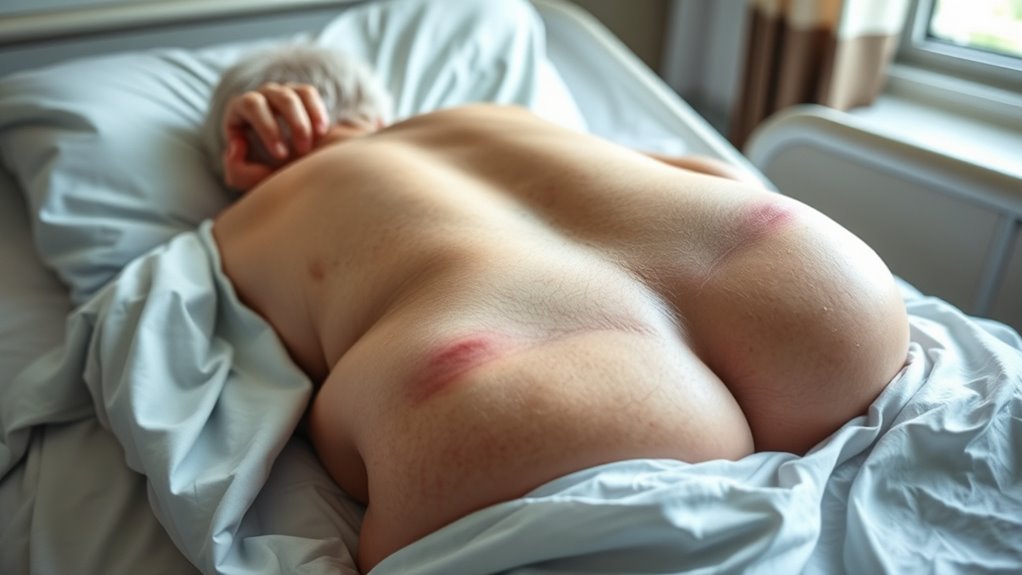
Bedsores, also known as pressure ulcers, develop when prolonged pressure cuts off blood flow to the skin and underlying tissues. This lack of circulation causes skin ischemia, which damages tissue and creates open wounds. You’re most at risk if you’re immobile, have fragile skin, or suffer from poor circulation. Other factors include advanced age, incontinence, and malnutrition, which weaken skin integrity and make it more vulnerable. Constant pressure on bony areas like the hips, heels, and sacrum impairs blood flow, leading to tissue death. The longer pressure persists without relief, the greater your risk of developing pressure ulcers. Understanding these causes and risk factors helps you recognize early warning signs and take steps to prevent skin ischemia and subsequent bedsores. Recognizing risk factors such as immobility and poor circulation is essential in early intervention and prevention efforts. Incorporating regular repositioning and skin assessments can further reduce the likelihood of pressure ulcer development.
Implementing Proper Repositioning Techniques
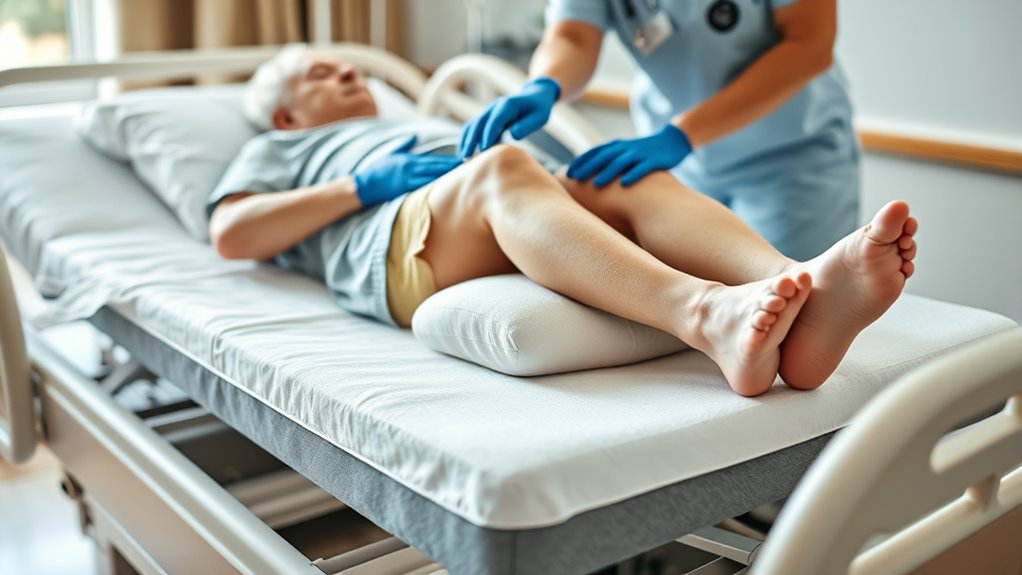
To prevent pressure ulcers from forming, it’s essential to regularly change a senior’s position to relieve pressure on vulnerable areas. Proper repositioning maintains skin integrity and reduces the risk of pressure ulcers. You should aim to shift their weight every two hours, ensuring that no one area bears excessive pressure. Use supportive devices like cushions or foam pads to offload pressure points. When repositioning, always check for signs of skin breakdown or redness. Remember, consistent movement helps keep blood flow healthy and skin resilient. To illustrate, here’s a quick guide:
| Repositioning Technique | Key Focus |
|---|---|
| Lateral turns | Spread pressure evenly |
| Elevating head of bed | Reduce pressure on sacrum |
| Assisted sitting | Prevent sliding and skin friction |
| Repositioning devices | Support skin integrity |
Additionally, using supportive devices can further help distribute pressure and protect vulnerable skin areas. Regularly incorporating pressure redistribution strategies enhances overall skin health and prevents ulcers. Engaging in preventive measures like routine skin assessments is also vital to catch early signs of pressure damage. Implementing proper repositioning techniques is crucial in maintaining skin health and preventing pressure ulcers.
Ensuring Nutritional Support for Skin Health
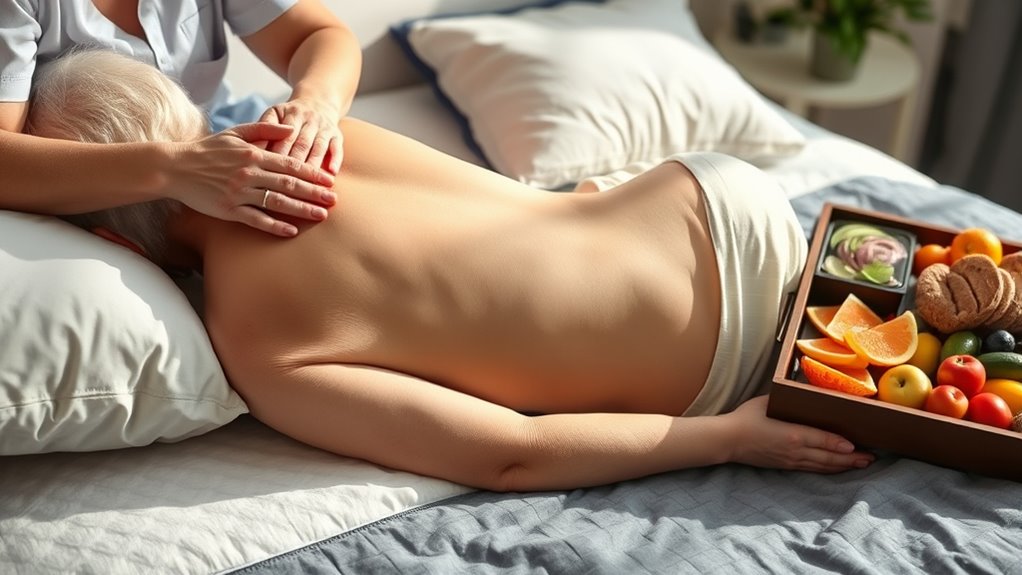
Maintaining proper nutrition plays a vital role in supporting healthy skin and preventing pressure ulcers. To do this, focus on providing balanced meals rich in vitamins, minerals, and protein, which are essential for skin repair and resilience. Nutritional supplements can help fill gaps if your senior’s diet is lacking, ensuring they receive adequate nutrients for skin health. Hydration strategies are equally important; encourage regular fluid intake to keep the skin supple and resistant to damage. Dehydration weakens skin tissue, increasing the risk of bedsores. Monitor your loved one’s hydration levels and promote drinking water, herbal teas, or broth throughout the day. Additionally, using a vetted electric bike conversion kit can facilitate easier outings for seniors, promoting mobility and overall well-being. Recognizing the importance of emotional bonds and social interaction can also contribute to overall mental health, which indirectly supports physical health. Staying aware of nutritional requirements can help tailor diets to meet individual needs and improve healing. Incorporating nutritional support strategies, including ensuring adequate intake of micronutrients like zinc and vitamins C and E, can further enhance skin integrity and repair processes. Proper nutrition, including a focus on sustainable food choices, can also support overall health and environmental impact. By prioritizing proper nutrition and hydration, you actively support their skin’s strength and improve their overall comfort and healing capacity.
Using Supportive Devices and Mattresses
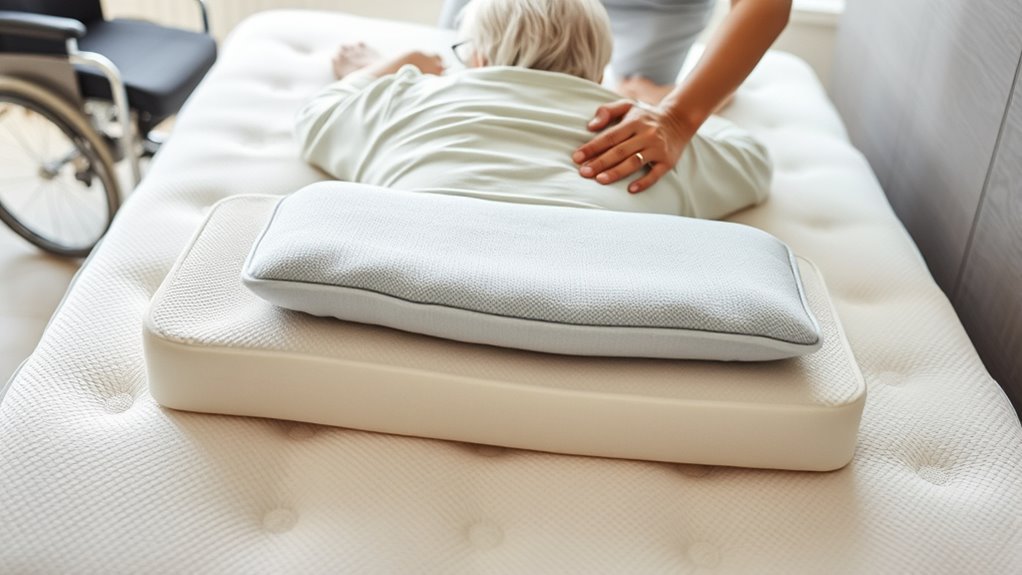
Using supportive devices and specialized mattresses can considerably reduce pressure on vulnerable areas, helping prevent the development of pressure ulcers. These tools help distribute body weight evenly, minimizing prolonged pressure that compromises skin integrity. Foam, gel, or air-filled mattresses are designed to cushion bony prominences like hips and heels, reducing friction and shear forces. Supportive cushions and pads can also be placed on chairs and wheelchairs to prevent pressure buildup during sitting. Additionally, selecting air purifier maintenance dos and don’ts that are easy to pronounce can help caregivers remember and encourage consistent repositioning of the patient. Proper use and regular repositioning, combined with these supportive tools, are key to protecting your loved one’s skin and reducing the risk of serious complications associated with pressure ulcers. Implementing pressure redistribution strategies is essential for comprehensive skin care. Moreover, understanding AI in adult entertainment highlights the importance of personalized approaches, which can also be applied to tailored pressure ulcer prevention plans.
Encouraging Mobility and Activity When Possible
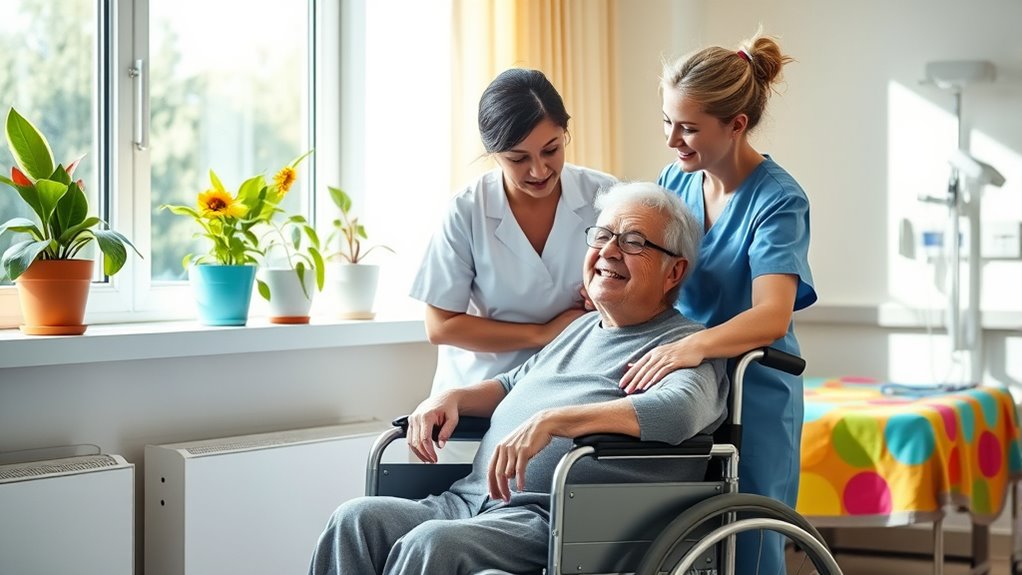
Encouraging your loved one to stay as active and mobile as possible can considerably reduce the risk of pressure ulcers. Simple exercise programs tailored to their abilities can boost circulation and prevent skin breakdown. Even gentle movements, like shifting positions or stretching, make a difference. Promoting social engagement also encourages movement; participating in group activities or conversations motivates seniors to stay active. Regular activity not only improves physical health but boosts mental well-being, making them more willing to move. Always listen to their comfort levels and consult healthcare providers for personalized recommendations. Incorporating AI-powered health tools can help monitor mobility and suggest suitable activities to support their well-being. By fostering a supportive environment that emphasizes activity and social interaction, you help lower the chances of bedsores developing and promote overall health and happiness.
Frequently Asked Questions
How Can Caregivers Identify Early Signs of Bedsores?
You should regularly perform skin assessments to spot early signs of pressure ulcers. Look for redness, discoloration, or warm, tender areas, especially over bony prominences. Keep an eye on any changes in skin texture or integrity. By frequently checking your loved one’s skin and recognizing these early signs, you can intervene promptly and help prevent the development of more serious pressure ulcers.
Are There Specific Skin Care Routines to Prevent Bedsores?
You should follow specific skin care routines to prevent bedsores. Use moisturizing techniques regularly to keep the skin hydrated and resilient. Incorporate skin inspection protocols into daily routines, checking for redness, swelling, or any signs of pressure damage. Keeping the skin clean, dry, and well-moisturized helps maintain its integrity, reducing the risk of sores. Consistent skin care and vigilant inspection are essential for early detection and prevention.
What Role Does Hydration Play in Bedsores Prevention?
Ironically, staying hydrated isn’t just about quenching thirst; it’s your skin’s best defense. Hydration importance can’t be overstated—adequate fluid intake keeps skin resilient and less prone to bedsores. Following fluid intake guidelines guarantees your skin remains supple and healthy. When you neglect hydration, your skin becomes fragile, increasing bedsores risk. So, drink enough water daily and listen to your body’s signals—your skin will thank you.
How Often Should Seniors Be Repositioned for Optimal Skin Health?
You should reposition seniors at least every two hours to prevent pressure ulcers. Regular movement helps maintain healthy skin and improves circulation, which are key parts of effective skin care routines. By shifting their position often, you reduce the risk of prolonged pressure that causes skin breakdown. Staying attentive to their comfort and skin condition guarantees you’re actively supporting their skin health and preventing painful pressure ulcers.
Can Certain Medications Increase the Risk of Bedsores?
Medications can be a double-edged sword, sometimes increasing your risk of bedsores. Certain drug interactions and medication side effects may cause dry skin, reduced mobility, or numbness, making it harder to shift positions. These factors create a perfect storm for pressure sores to develop. If you’re on medications, it’s essential to discuss potential side effects with your healthcare provider and stay vigilant about repositioning to protect your skin.
Conclusion
By staying proactive and attentive, you can markedly reduce the risk of bedsores in seniors. Remember, regular repositioning, proper nutrition, and supportive devices make a difference—sometimes just when you least expect it, a small change can prevent a painful complication. It’s a reminder that consistent care and awareness aren’t just routines; they’re the key to keeping your loved ones comfortable and healthy, often when you least think about it.
